#later le dynasty
Explore tagged Tumblr posts
Text

The Sixteenth Century Vietnamese Civil War. Source: Little Charm Hanoi Hostel website
In 1526, the insurgent Mac clan, supported by the Chinese and led by Mac Dang Dung, rose in rebellion against the Le dynasty and seized the Dai Viet throne, initiating the so-called “Mac Dynasty”. The Le retreated south and, supported by the powerful Nguyen and Trinh families, fought to regain the kingdom. The Mac/Le civil war lasted seventy years, ending with the restoration of the Le in 1592. The Mac were driven to a small region in the far north, on the Chinese border.
0 notes
Note
Is there any sort of supporting vampire index? I read the first five books back in high school and have been slowly making my way through the entire series (currently mid merrick) this year. But recently it feels like every other day someone brings up an important character from the later books that already appeared, or was implied in the show.
Nonny, you're in luck :)
Anne herself provides us with one in "Prince Lestat" and in "Prince Lestat and the Realms of Atlantis" :) Obviously the short descriptions refer to the book versions. I would take note of Sevraine (who is Gabrielle's implied girlfriend later on!), Seth and especially Fareed, and definitely Rhoshamandes and Amel here. Gregory, too. And Viktor (whose summary does not contain the reveal btw) and Rose. These at the very least :) - let me know if you want to know more details!
I'll paste the character list from PLatRoA here! SPOILERS though - so under the cut!
Characters and Places in the Vampire Chronicles
Akasha—Queen of ancient Egypt six thousand years ago, and the first vampire ever created, through a merger with the spirit Amel. The story is told in The Vampire Lestat and in The Queen of the Damned.
Allesandra—A Merovingian princess, daughter of King Dagobert I, brought into the Blood in the seventh century by Rhoshamandes. First introduced in The Vampire Lestat as a mad nameless vampire living with the Children of Satan under Les Innocents Cemetery in Paris. She also appears in The Vampire Armand in the Renaissance where she is named, and later in Prince Lestat and Prince Lestat and the Realms of Atlantis.
Amel—A spirit who created the first vampire six thousand years ago by merging with the body of the Egyptian Queen Akasha. The story is told in The Vampire Lestat and in The Queen of the Damned. Prince Lestat and Prince Lestat and the Realms of Atlantis continue the story of Amel.
Antoine—A French musician exiled from Paris to Louisiana and brought into the Blood by Lestat around the middle of the nineteenth century. Referred to as “the musician” in Interview with the Vampire. Later appears in Prince Lestat and Prince Lestat and the Realms of Atlantis. A talented violinist and pianist and composer.
Arion—A black vampire of ancient times introduced in Blackwood Farm. At least two thousand years old, perhaps older. Possibly from India.
Arjun—A prince of the Chola dynasty in India, brought into the Blood by Pandora around 1300. Appears in Blood and Gold and also in Pandora.
Armand—One of the pillars of the Vampire Chronicles. Armand is a Russian from Kiev, sold into slavery as a boy, and made a vampire in Renaissance Venice by the Vampire Marius. He is introduced in Interview with the Vampire, and appears in numerous novels in the Vampire Chronicles, telling his own story in The Vampire Armand. The founder of the coven at Trinity Gate in New York. Armand maintains a house in Paris in Saint-Germain-des- Prés, which functions as the Paris Court for Prince Lestat.
Avicus—An Egyptian vampire who first appears in Marius’s memoir, Blood and Gold. Appears again in Prince Lestat.
Benedict—A Christian monk of the seventh century in France, brought into the Blood by Rhoshamandes. Benedict is the vampire from whom the alchemist Magnus stole the Blood, a theft described in The Vampire Lestat. Appears in Prince Lestat and Prince Lestat and the Realms of Atlantis as Rhoshamandes’s companion and lover.
Benji Mahmoud—A twelve-year-old Palestinian Bedouin boy, brought into the Blood by Marius in 1997. Benji originates the vampire radio station heard round the world in Prince Lestat. Resides at Trinity Gate in New York and sometimes at the Court of Prince Lestat in France. First appears in The Vampire Armand when he is living in New York with his companion, Sybelle.
Bianca Solderini—Venetian courtesan brought into the Blood by Marius in Blood and Gold around 1498.
Château de Lioncourt—Lestat’s ancestral castle in the Massif Central in France, splendidly restored and the home of the new dazzling and glamorous Court of the Vampires with its orchestra, theater, and frequent formal balls. The adjacent village, including an inn and a church and several shops, has also been restored to house mortal workers and visitors to the Château.
Children of Satan—A network of medieval vampire covens, populated by vampires who sincerely believed they were children of the Devil, doomed to roam the world in rags, accursed, feeding on the blood of innocent humans to do the Devil’s will. Their most famous covens were in Rome and in Paris. The coven kidnapped many of the fledglings of Rhoshamandes until he finally left France to get away from them. And the Children of Satan in Rome spelled catastrophe for Marius and his great Venetian household in the Renaissance. Armand told of his experiences with the Children of Satan in The Vampire Armand.
Chrysanthe—A merchant’s widow from the Christian city of Hira, brought into the Blood by Nebamun, newly risen and named Gregory in the fourth century. Wife of Gregory. Introduced, along with Gregory, in Prince Lestat.
Cimetière des Innocents—An ancient cemetery in the city of Paris until it was destroyed near the end of the eighteenth century. Underneath this cemetery lived the Coven of the Children of Satan, presided over by Armand, which is described by Lestat in The Vampire Lestat. Referred to in the novels as “Les Innocents.���
Claudia—An orphan of five or six years old, brought into the Blood around 1794 by Lestat and Louis in New Orleans. Long dead. Her story is told in Interview with the Vampire. Later appears as a spirit in Merrick, though the appearance is suspect.
Cyril—An ancient Egyptian vampire, maker of Eudoxia in Blood and Gold, and named for the first time in Prince Lestat. Age unknown.
Daniel Molloy—The nameless “boy” interviewer in Interview with the Vampire. Brought into the Blood by Armand in The Queen of the Damned. Also appears in Blood and Gold living with Marius. Also in Prince Lestat.
David Talbot—Introduced as an elderly member of the Talamasca, an order of psychic detectives, in The Queen of the Damned. Becomes an important character in The Tale of the Body Thief, and also solicits Pandora’s story from her in Pandora. A pillar of the Vampire Chronicles.
Davis—A black dancer from Harlem, a member of the Fang Gang, brought into the Blood by Killer sometime in 1985. Introduced in The Queen of the Damned. Further described in Prince Lestat.
Eleni—A survivor of the Children of Satan who helps found the Théâtre des Vampires in Paris in the eighteenth century; corresponds with the Vampire Lestat after he leaves Paris to travel the world. A fledgling of Rhoshamandes made a vampire in the early Middle Ages.
Enkil—Ancient King of Egypt, husband of the great Queen Akasha, the second vampire to be brought into existence. His story is told in The Vampire Lestat and The Queen of the Damned.
Everard de Landen—A fledgling of Rhoshamandes from the early Middle Ages who first appears in Blood and Gold and is named in Prince Lestat.
Fareed—Anglo Indian by birth, a physician and researcher, brought into the Blood by Seth to be a healer and researcher of the vampires. A major character introduced in Prince Lestat.
Flannery Gilman—An American female medical doctor, biological mother of Viktor, and brought into the blood by Fareed and Seth. Part of their medical and research team working with the Undead.
Flavius—A Greek vampire, a slave purchased by Pandora in the city of Antioch and brought into the Blood by Pandora in the early centuries of the Common Era.
Gabrielle—Lestat’s mother, a noblewoman of breeding and education, brought into the Blood by her own son in 1780 in Paris. A wanderer who dresses in male attire. A familiar figure in the background throughout the Vampire Chronicles.
Gregory Duff Collingsworth—Known as Nebamun in ancient times, a lover of Queen Akasha and made a blood drinker by her to lead her Queens Blood troops against the First Brood. Known today as Gregory, owner of a powerful pharmaceutical empire in the modern world. Husband of Chrysanthe.
Gremt Stryker Knollys—A powerful and mysterious spirit who has created for himself over time a physical body that is a replica of a human body. Connected with the founding of the secret Order of the Talamasca. Introduced in Prince Lestat.
Hesketh—A Germanic cunning woman, brought into the Blood by Teskhamen in the first century. Now a ghost who has managed to produce a physical body for herself. Also connected with the origins of the secret Order of the Talamasca. Introduced in Prince Lestat.
Jesse Reeves—An American woman of the twentieth century, a blood descendant of the ancient Maharet and brought into the Blood by Maharet
herself in 1985 in The Queen of the Damned. Jesse was also a mortal member of the Talamasca and worked with David Talbot in the Order.
Khayman—An ancient Egyptian vampire, made by Queen Akasha, and rebelling against her with the First Brood. His story is told in The Queen of the Damned.
Killer—An American male vampire, founder of the Fang Gang in The Queen of the Damned. Of unknown history or origin.
Lestat de Lioncourt—The hero of the Vampire Chronicles, made a vampire by Magnus near the end of the eighteenth century, the maker of a number of vampires, including Gabrielle, his mother; Nicolas de Lenfent, his friend and lover; Louis, the narrator of Interview with the Vampire; and Claudia, the child vampire. Presently known as Prince Lestat by one and all.
Louis de Pointe du Lac—The vampire who started the Vampire Chronicles by telling his story to Daniel Molloy in Interview with the Vampire, an account of his own origins, which differs in some ways from Lestat’s own account in The Vampire Lestat. A French colonial plantation owner made a vampire by Lestat in 1791. Appears most prominently in the first Chronicle, and in Merrick, and in Prince Lestat and Prince Lestat and the Realms of Atlantis.
Magnus—An elderly medieval alchemist who stole the Blood from a young vampire, Benedict, in France. The vampire who kidnapped and brought Lestat into the Blood in 1780. Now a ghost, sometimes appearing solid, and at other times as an illusion.
Maharet—One of the oldest vampires in the world, twin to Mekare. The twins are known for their red hair and their power as mortal witches. Made at the dawn of Vampire History, they are rebels leading the First Brood against Queen Akasha and her Queens Blood vampires. Maharet is beloved for her wisdom and for following all of her mortal descendants through the ages all over the world, whom she called the Great Family. Maharet tells her story—the story of the twins—in Queen of the Damned. She also figures in Blood and Gold and in Prince Lestat.
Marius—A pillar of the Vampire Chronicles. A Roman patrician who is kidnapped by the Druids and brought into the Blood by Teskhamen in the first century. Marius appears in The Vampire Lestat and numerous other books, including his own memoir, Blood and Gold. A vampire known for reason and gravitas. Much loved and admired by Lestat and others.
Mekare—Maharet’s twin sister, the powerful red-haired witch who communed with the invisible and potentially destructive spirit Amel, who later went into the body of Queen Akasha, creating the first vampire. The story of Mekare and Maharet is first told by Maharet in The Queen of the Damned. Mekare figures in Blood and Gold and in Prince Lestat.
Memnoch—A powerful spirit claiming to be the Judeo-Christian Satan. He tells his story to Lestat in Memnoch the Devil.
New Orleans—Figures prominently in the Vampire Chronicles as the home of Louis, Lestat, and Claudia for many years during the nineteenth century, at
which time they resided in a townhouse in the Rue Royale in the French Quarter. This house still exists and is in the possession of Lestat today, as it has always been. It was in New Orleans that Lestat encountered Louis and Claudia and made them vampires.
Notker the Wise—A monk and a musician and a composer brought into the Blood by Benedict around A.D. 880, maker of many boy-soprano vampires and other vampire musicians yet unnamed. Living in the Alps. Introduced in Prince Lestat.
Raymond Gallant—A faithful mortal scholar of the Talamasca, a friend to the Vampire Marius, presumed dead in the sixteenth century. Appears again in Prince Lestat.
Rhoshamandes—A male from ancient Crete, brought into the Blood at the same time as the female Sevraine, about five thousand years ago. A powerful and reclusive vampire obsessed with operatic music and performances, and the lover of Benedict. Lives in his castle on the island of Saint Rayne in the Outer Hebrides, traveling the world from time to time to see different operas in the great opera houses.
Rose—An American girl, rescued as a small child by Lestat from an earthquake in the Mediterranean around 1995. His ward. Lover and later spouse of Viktor. Introduced in Prince Lestat.
Saint Alcarius, Monastery of—The secret residence of Gremt, Teskhamen, and other supernatural elders of the Talamasca in France, near the Belgian border.
Saint Rayne— The island on which Rhoshamandes lives. Santino—An Italian vampire made during the time of the Black Death.
Longtime Roman coven master of the Children of Satan. Presumed dead.
Seth—The biological son of Queen Akasha, brought into the Blood by her after a youth of roaming the ancient world in search of knowledge in the healing arts. He is introduced in Prince Lestat and is the maker of Fareed and Flannery Gilman.
Sevraine—A remarkably beautiful Nordic female vampire, made by Nebamun (Gregory) against Akasha’s rules. Sevraine maintains her own underground court in the Cappadocian Mountains. A friend to female vampires. Introduced in Prince Lestat.
Sybelle—A young American pianist, beloved friend of Benji Mahmoud, and Armand, brought into the Blood by Marius in 1997. Introduced in The Vampire Armand.
The Talamasca—An ancient order of psychic detectives or researchers, dating back to the Dark Ages—an organization of mortal scholars who observe and record paranormal phenomena. Their origins are shrouded in mystery until they are revealed in Prince Lestat. They have Motherhouses in Amsterdam and outside of London, and retreat houses in many places, including Oak Haven in Louisiana. First introduced in The Queen of the Damned and
figuring in many Chronicles since. Vampires Jesse Reeves and David Talbot were mortal members of the Talamasca.
Teskhamen—Ancient Egyptian vampire, the maker of Marius as told by Marius in The Vampire Lestat. Presumed dead until modern times. Connected with the origins of the Talamasca. First named in Prince Lestat.
Théâtre des Vampires—A boulevard theater of the macabre, created by the refugees from the Children of Satan, funded by Lestat, and managed for decades by Armand, who had once been the coven master of the Children of Satan.
Thorne—A red-haired Viking vampire, made centuries ago in Europe by Maharet. Introduced in Blood and Gold.
Trinity Gate—A coven dwelling made up of three identical townhouses just off Fifth Avenue on the Upper East Side of New York. Armand is the founder of Trinity Gate. And it functions now as the American Court of Prince Lestat.
Viktor—An American boy, biological son of Dr. Flannery Gilman. His story is revealed in Prince Lestat. Lover and later spouse of Rose, Lestat’s ward.
#Anonymous#ask nalyra#amc iwtv#iwtv#amc interview with the vampire#interview with the vampire#the vampire chronicles#vc#vampire chronicles#vampires#vampire index#index#characters#tvc
54 notes
·
View notes
Text





Sean bienvenidos japonistasarqueológicos, una nueva entrega en esta ocasión hablaremos del Tanabata una vez dicho esto pónganse cómodos que empezamos. - ¿Qué es el tanabata?¿Cuándo se celebra?¿Cuál es su origen?El tanabata, surge en China en la dinastía Han que posteriormente llegará a Japón durante el período Nara (710 d.C.- 794 d.C.) a través de la nobleza ,pero no fue hasta el período Edo (1600-1868) que se hizo popular. Esto lo podemos ver en el anime como es el caso de Doraemon (ドラえもん), pero hay montones de animes que tratan esta temática una película que trata estos temas podrían ser: Amor de Gata, Kimi no Nawa, Kimetsu no Yaiba podría hacer una lista que nunca acabaria de la cantidad de anime que hay que trata el Tanabata. ¿Qué es el tanabata? Cuenta la leyenda de Orihime y Hikoboshi que solo se pueden ver la séptima luna del séptimo mes, se crea un puente que les permite cruzar y estar juntos ¿Cuándo se celebra? Se celebra el 7 de julio y lo más característico de esta festividad son los fuegos artificiales y en Tokyo por ejemplo: el templo Zojoji, pero cualquier templo lo podréis apreciar muy bien. tanzaku ¿En qué consiste? Se coloca un trozo de papel con tu deseo y se colocan en árboles de bambú. Para terminar me gustaría mencionar que hay una constelación que representa esta maravillosa historia. - Espero que os haya gustado y nos vemos en próximas publicaciones que pasen una buena semana. - ようこそ、日本の��古学者たちへ。今回は七夕についてお話します。 - 七夕とは何か、いつ祝うのか、その起源は? 七夕は中国の漢の時代に始まり、奈良時代に貴族を通じて日本に伝わった。 ドラえもんなどのアニメに見られるが、このテーマを扱ったアニメはたくさんある:七夕を扱ったアニメは枚挙にいとまがない。織姫と彦星は七夕の日にしか会えないという伝説がある。 いつ祝うの?月7日に行われます。このお祭りの最大の特徴は花火で、東京では増上寺が有名ですが、どこのお寺でもよく鑑賞できます。 短冊 短冊とはどんなものですか?願い事を書いた紙を竹に貼る。最後に、この素晴らしい物語を象徴する星座があることをお伝えしたい。 - それでは、また次の記事でお会いしましょう。
Welcome to the Japanese archaeologists, this time we are going to talk about Tanabata, so make yourselves comfortable and let's get started. - What is tanabata, when is it celebrated, what is its origin? Tanabata, which originated in China in the Han dynasty, later came to Japan during the Nara period (710 AD - 794 AD) through the nobility, but it was not until the Edo period (1600-1868) that it became popular. This can be seen in anime such as Doraemon (ドラえもん), but there are lots of anime that deal with this theme, a movie that deals with these themes could be: Love of Cat, Kimi no Nawa, Kimetsu no Yaiba I could make a list that would never end of the amount of anime out there that deals with Tanabata. what is tanabata? Legend has it that Orihime and Hikoboshi can only see each other on the seventh moon of the seventh month, a bridge is created that allows them to cross and be together. When is it celebrated? It is celebrated on the 7th of July and the most characteristic of this festivity are the fireworks and in Tokyo for example: the Zojoji temple, but you can appreciate it very well in any temple. tanzaku What does it consist of? You put a piece of paper with your wish on it and place it on bamboo trees. Finally, I would like to mention that there is a constellation that represents this wonderful story. - I hope you liked it and see you in the next posts have a nice week.
#日本#中国#アニメ#オタカス#日本人#平安#ディナスティアハン#時代#天文#星座#伝説#伝統#織姫#彦星#ドラえもん#アモルデガタ#君縄#金津乃矢場#-#japan#china#anime#otacus#japanese#heian#dinastiahan#period#astronomy#constellations#history
79 notes
·
View notes
Text
Yes, well—
Just then, the cushion below shifted rather violently with Eugène’s yelp at once. The wide-eyed marshal whipped his head around to be greeted with the sight of the viceroy (currently resembling a blob in his vision) being pressed against the sofa by his feathery family...Lord lend him strength to not burst out laughing at this.
Comicality of their situation aside, after that extraordinary display of strength…it was clear that the Imperial eagle was no ordinary eagle— it's best they tread lightly.
That is…the Empereur, my friend.
He whispered to his fellow marshal-turned-owl swiftly, still holding him at a reasonable distance from the larger avian before steering their attention towards the predicament next to him and clearing his throat.
Right...
Ah. Hm...typically a parent bird would be able to detect when their young is in distress— perhaps you could...squirm around a bit?
Whether or not such a statement would apply to a stubborn man (bird?) like Napoleon would depend on his response to Eugène's suggestion— for now, it was best to wait and see just how much the eagle could comprehend human speech...
《 @alexanderfanboy , @le-fils , @frencheaglet , @bow-and-talon 》
Feathery Insanity
— @alexanderfanboy , @le-fils , @bow-and-talon , @frencheaglet —
[[ 1 , ... ]]
——————————•
Davout wasn't exactly sure if his perpetual lack of body warmth could help keep the small eagle comfortable, or how much human characteristics Napoleon's feathered form actually retained; the emperor did appear to be more...animalistic compared to other transformations he had observed. However, his latter inquiry was swiftly answered with the sight of the Marquis in between the emperor's large talons, screeching with all the might his little body could muster.
...Sire, that— AH—!
Alarmed, Davout attempted to calmly sway the Napoleon eagle to let go of the delicate Saint-Cyr in his grasp— an attempt quickly quelled by said subject of concern being practically squashed into his face just seconds later, knocking his glasses off clean during the struggle.
Sire—! ouff! The chick requires— consistent warm, I was— ack—! Let me explai—! Oh, to hell with this! Fine, fine!
After a brief wrestle with a GODDAMNED EAGLE and common sense had finally kicked in, Davout managed to return the eaglet and its makeshift nest in exchange for his disconcerted owlish comrade— thankfully without committing accidental means cannibalism. (Save for the feathers that landed in his mouth.)
Ugh, pleh... [*ptui!*] ...Eugh.
Whether it was from concern for his friend, annoyance at his sudden blindness, or both; the marshal blinked at the avian in his hand and squinted at him with a puzzled yet agitated look.
Gouvion? You...! How in the blazes are you still an owl? What are you doing out in the open? Are you harmed?
#event - eagle dynasty#échanges avec le prince de venise#échanges avec le marquis#[[will tag properly later]]
21 notes
·
View notes
Text
There's just so many things I want to say about the 1903 Su Manshu's translation of Les Misérables
It is a unique AU adaptation fanfic translation
I will put some kind of a list of observations that is sorted out, since right now all the information is falling out of my brain like a waterfall at the moment. There's just so many things one person can keep in about this liquid of an information.
If the translation is so different from the original, do we categorise it as a translation or an adaptation? I mean like, e.g. Jean Valjean tries to kill, then successfully robs the writer's political and religious mouthpiece Hero after he releases Jean Valjean from prison, etc.
The whole thing is so wild that "one of the main characters try to assassinate Napoleon but fails and thus dies from suicide" fact is mentioned in the footnote in the paper I'm reading; as if it's the least of our problems, because there's just so much going on.
Su was multilingual, but probably not in French. Instead, he translated from Charles E. Wilbour. And due to it being published in volumes, and it being hard to get by because how fast it sold, he only have access to volume one, apparently.
Even then, he minused Book 1 because it was too praise-y of Christianity via Bishop Myriel.
Oh, did I not mention? He hates Christianity, and he definitely hates the Bishop. That's why he deleted Book 1: it had too many nice things to say about the greedy and hypocritical Bishop.
「When in the English text Valjean asks whether the Bishop would like payment for his stay, the response is:
“No,” said the bishop; “keep your money. How much have you? You said one hundred and nine francs, I think.” (Wilbour, p. 48)
But Su translates:
孟主教果急忙答道:“不然,不然,一定要算饭钱的。你共有多少钱呢?你曾说你有一百零九个银角子。” (Su, p. 58)
Bishop Myriel answered in a hurry as expected, “Yes, yes, of course. You have to pay for your meal. How much money do you have in total? You told me you have one hundred and nine silver coins.”」
(Li Li, Su Manshu’s Adaptation of Les Misérables: The Manipulation of a Bridging Text in an Activist Translation. Translation and Literature. 2022)
Li Li suggests it might've also been because Su wasn't as fluent in English as we thought as well, since there are some misunderstandings of meaning (that bears no political or religious sway) in his translation.
On the topic of translation, there is also an excerpt I would like to share.
Su was writing during the nearing end of Qing Dynasty, and he was against the said Dynasty and thus was a revolutionist. If people were too critical and loud about their thoughts on the governing body and Confucianism, then the ruling class would've prosecuted him.
And thus, he had to cover his tracks and make sure he wasn't caught saying anything incriminating. He did this with his self-insert Ming Nande, and he did it with other contexts such as here:
[Quote:]
「In this moment Nande knew it was the girl that he was worrying about. Then he affectionately held up her slim waist and kissed her several times (This is a western custom, please don't be surprised!)."
这时,男德才知道是他心里所惦记的美人,急忙亲亲热热地用手一把搂住那美人的细腰,连亲了几个��(这是西俗,看官别要见疑)」
(Translation by Li Li, 2022)
I will definitely talk about this more at a later date because I have to go to Scotland, so I'm probably going to be travel-stressing xD
Even though I can't share the PDF of the essay paper that I have, I do have the link to a publicly shared webpage by the same author with her summarised thoughts on this translation, so please take a look if you're interested!
16 notes
·
View notes
Note
wait hiiiii hi hello bestie i didn’t know u like video essays!! i’ve been trying to find more to watch recently, do u have any other recs? about any topic 👀
HIIIIII bestie Robin, are you ready?? After harvesting my Youtube subscription and liked video lists here is what I have compiled. I'm gonna put my current top 5 video recommendations and then the rest of the list, under the cut, is organized by creator.
Why Are There So Many Confederate Vampires
The art of religious interpretation (midnight mass vs god’s not dead)
Defunctland: Walt Disney's City of the Future, E.P.C.O.T.
Hogwarts Legacy, JK Rowling, and Trans Advocacy
Cultural Inspirations in Avatar: The Last Airbender Book 1 - Water
CHANNELS
biz barclay - hilarious, brilliant, my best friend who drinks wine and weaves me long insightful stories while sitting on the dresser or in the bathtub. The vast amount of knowledge, historical
understanding snapewives: religion, fandom, sociology, & erotica
Goncharov (1973) video essay
The art of religious interpretation (midnight mass vs god’s not dead)
Xiran Jay Zhao - Author of one of my FAVE YA novels, “Iron Widow” (which is a MUST read). I always want more avatar content that focuses on cultural inspirations from trusted sources. Xiran taught me so much about the avatar universe I already loved as well as valuable critiques. They also do retellings of historical events such as- Bisexual Han Dynasty Emperors and Forgotten Warrior Queen - Fu Hao.
Cultural Inspirations in Avatar: The Last Airbender Book 1 - Water
Cultural Inspirations in Avatar: The Last Airbender Book 2 - Earth
Cultural Inspirations in Avatar: The Last Airbender Book 3 - Fire
Fundie Fridays - Jen, a leftist queer feminist, and her husband James examine different aspects of Christian fundamentalism, American conservative politics and pop culture. She has remade a lot of her older videos so make sure to watch the updated versions! She was also featured in the Amazon docuseries “Shiny Happy People” which I would HIGHLY recommend.
Vacation Bible School of Rock (3 part video series History of Contemporary Christian Music)
Ken Ham’s Creation Museum & Ark Encounter
Ask a Mortician - Caitlin Doughty!!! The adult Wednesday Addams we should have got. So compassionate, informed, and moving!! I love her work and she has taught me so much about what it means to have a relationship with death and grief. Her work deals with heavy topics and you can tell she does this work from a deeply respectful, informed place.
The Lake That Never Gives Up Her Dead
Let’s Visit the Churches Made of Human Skulls
Why are Black and White Funeral Homes STILL Separate? With Dr. Kami Fletcher
Iconic Corpse Series
Princess Weekes - Nuanced video essays on pop culture, race, feminism, and other social issues. Takes time to break down complex concepts, their origins and material consequences. The essay on confederate vampires and the connection later made to sci-fi media like Firefly were so paradigm shifting to me!
Why Are There So Many Confederate Vampires
The Magical Negroes of Stephen King
Ro Ramdin - Poetic, biting, and introspective essays on pop culture.
Do Celebrities Hate Their Fans? (Doja Cat, Frank Ocean)
Hogwarts Legacy, JK Rowling, and Trans Advocacy
DefunctLand- History of extinct theme parks and themed entertainment experiences.
Defunctland: Walt Disney's City of the Future, E.P.C.O.T.
Disney Channel’s Theme: A History Mystery
Mina Le - Fashion, movies and pop culture
WHY IS EVERYTHING SO UGLY: The Curse of Modernism
FAIRYTALE COSTUMES: it’s giving renfaire but why?
Quinton Reviews - Extensive videos covering niche topics, most popular for Nickelodeon deep dive retrospectives.
How Documentaries Lie to You
The ICarly/Victorious Saga Playlist
TheEpicNate315 - yea i fucking love endless hours of useless skyrim lore because the conspiracies are so deep and I have to do 0 of the research to get all of the information years of scouts worked to piece together!
The Skyrim Mysteries Iceberg (Part 1 of 4)
The Fallout Mysteries Iceberg (Part 1 of 2, incomplete series)
Mike’s Mic - Silly, goofy, and thorough breakdowns of nostalgic TV shows
Any of his unhinged recaps - LOST, Pretty Little Liars, Glee
Tiffanyferg - Media criticism and commentary
Internet Analysis Series
Zoë Ligon - sex educator, artist, and writer, who also owns SpectrumBoutique.com, a health and education oriented sex toy store. Such a special place in my heart for her!! Her bondage mini-documentary with Midori was so touching.
Sex Stuff | Japanese Rope Bondage with Midori
Channels Newer to Me
Broey Deschanel - a mixture of film analyses, retrospectives, politics and just absolutely overthinking anything to do with pop culture
Elvis (2022) and the Utter Mediocrity of Biopics
Meeptop - rambling about movies and stuff
Who is Dahmer Even Made For?
LadyJenevia - discussing entertainment media content including films, television series, etc. Expect to find reviews of recent cinematic releases, video essays on older releases, and interviews with talent from the film/television industry
Glass Onion: A Knives Out Mystery and The Art of Hiding in Plain Sight (Netflix Review/Video Essay)
As a disclaimer, I am not endorsing any creator fully and if you see someone you think I should not promote please reach out to me so I can edit this list. As a general rule of thumb the more I had to write about someone, the more informed the recommendation.
#if you read/watch this monster list thank you and I hope you enjoy!!#you can really see my niche interests displayed here lmao#send me asks if you have questions! or have recommendations for me!!#boybff reccomendations#video analysis#video essay reccomendations#video essay#YouTube recommendations
84 notes
·
View notes
Text
"The two leads are fantastic: Stan navigates from naïve wannabe to glowering mogul and never loses his way or slips into parody. His vanity about his hair and his looks is on display from the beginning, but in the early years he is unsure of himself and there is a vulnerability about him. Strong is also utterly believable as Cohn, a man as vain as his disciple and certainly as dangerous."
The Standard
The Apprentice review: Sebastian Stan shines in drama about how Donald Trump went from wannabe to mogul (click for article)
This origin story does an excellent job of showing the rise and rise of Donald Trump
Jo-Ann Titmarsh
4 out of 5 stars
One of the hottest tickets in Cannes this year is Iranian director Ali Abbasi’s The Apprentice, his tale of the rise and rise of Donald Trump.
The apprentice in question is Trump himself (Sebastian Stan), while the master he serves and later usurps is Roy Cohn (Jeremy Strong), a lawyer who hobnobs with leaders and has the ear of the president.
Cohn is ruthless and will stop at nothing to attain what he wants, often in the name of a patriotism which equals hard-right conservatism.
The film opens in 1970s New York. Donald is a baby-faced teetotal rent collector for his dad, but he yearns to break free of his father’s grip and strive for greater things, obsessing over the tycoons and millionaires that frequent Le Club.
This is where he meets Cohn who takes Trump under his wing and instructs him to follow his three essential tenets, which are all about achieving, denial and how even a defeat can be turned into a win.
Abbasi deftly recreates the feel of the city and the darkness of those years. And what starts gritty becomes colourful once Ivana (Maria Bakalova) appears her platinum blonde hair, scarlet dress and matching glossy lips.
The other important people are his family members. Martin Donovan plays Fred, the abusive and monstrous family patriarch. Donald’s mother Mary (Iona Rose MacKay) is a less forceful presence, while Trump’s brother Freddy (Charlie Carrick) is sympathetically depicted as a man slowly but irrevocably broken by his father’s contempt.
As the film moves into the 1980s, the look changes completely as the Eighties vibe comes clearly into focus, like walking into the neon-lit bathroom of a dingy club.
There is nothing but tackiness here, that harsh lighting revealing the deals in Atlantic City, the over-the-top décor of the Trump home and the gaudiness of the couple’s life together, even as their relationship falls apart.
The harshness also highlights Trump’s ascension as Cohn begins to falter and the apprentice becomes the master.
The film ends with Trump drafting his book The Art of the Deal, in which he dictates those three tenets drummed into him by Cohn. Nothing about Trump is original. Nothing has been gained by him alone. And there is nothing he won’t do to get what he wants.
The two leads are fantastic: Stan navigates from naïve wannabe to glowering mogul and never loses his way or slips into parody. His vanity about his hair and his looks is on display from the beginning, but in the early years he is unsure of himself and there is a vulnerability about him. Strong is also utterly believable as Cohn, a man as vain as his disciple and certainly as dangerous.
It’s hard not to bring up comparisons with Succession here: a New York dynasty, a tyrannical father, the wealthy elite, the presence of Jeremy Strong who played Kendall Roy… there’s even a fleeting glimpse and mention of Rupert Murdoch, whom Cohn says Trump should cosy up to. And then there’s the excellent music by Martin Dirkov, which has echoes of the Succession theme.
There are some problems, the story is too linear and the screenplay, by Gabriel Sherman, full of scenes seen many times before, such as Cohn chasing after Trump in the street begging for an audience or Donald refusing his calls, and the director could have been more inventive in the fil. However, there is a lot of humour here, particularly thanks to the character of Cohn, and almost always at Trump’s expense.
The Apprentice is not going to change anyone’s mind about Trump, who is so vain that he will almost certainly love this film, despite the references to his plastic surgery and big butt.
But Abbasi does an excellent job of showing us how and why Trump became the Trump of today and how his path to presidency was paved.
#the apprentice#the apprentice movie#the apprentice review#sebastian stan#donald trump#jeremy strong#roy cohn#maria bakalova#ivana trump#ali abbasi
12 notes
·
View notes
Text
I adore political fantasy/sci fi to absolute pieces. Here are some happy places:
The Foreigner Series by C.J. Cherryh
The Left Hand of Darkness by Ursula K Le Guin (okay so its mostly about gender fuckery but the driving force is xenophobia and not in the direction you think)
The Goblin Emperor by Katherine Addison
Nirvana in Fire/Lang Ya Bang by Hai Yan
Chéng Huà Shísì Niá/ The Sleuth of Ming Dynasty by Meng Xishi (romance is important here and so are cases but gosh the overarching context and political situation are fantastic)
All off the top of my head. If I remember more maybe I'll add later. Honorable mention to Wheel of Time by Robert Jordan. The magic destiny overrules all, but boy do politics count. I do not count George R R Martin as his first book bored me.
Please, if people have more . . . I need them.
#politics in fantasy and sci fi#book recs#i need more people drinking tea ominously please#its why i end up in cdrama land
2 notes
·
View notes
Text
History surrounding the Samoan Dynasty logo from Roman's Uncle Reno "Count of the Black Pearl" Anoa'i.
Credit to the Samoan Dynasty Facebook page and to Les from Acknowledge The Dynasty podcast for finding this little history lesson.


Bonus fun fact: Reno is the one who came up with the idea for the Superman punch. Initially he offered it to Jacob Fatu who turned it down. A couple of years later he taught it to Roman instead who happily accepted it.
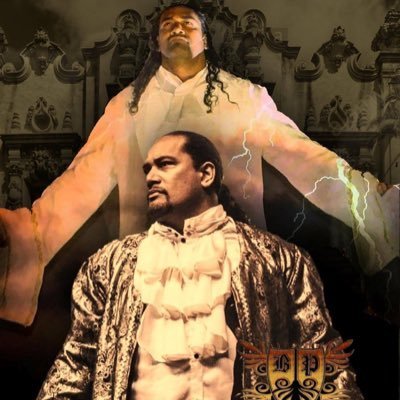
#Roman Reigns#the tribal chief#wwe roman reigns#roman reigns#head of the table#the head of the table#joe anoa'i#the only one#anoa'i#the samoan dynasty#anoa'i family#samoan dynasty#count of the black pearl#reno anoa'i#the bloodline#wwe bloodline#samoan dynasty facts
14 notes
·
View notes
Text
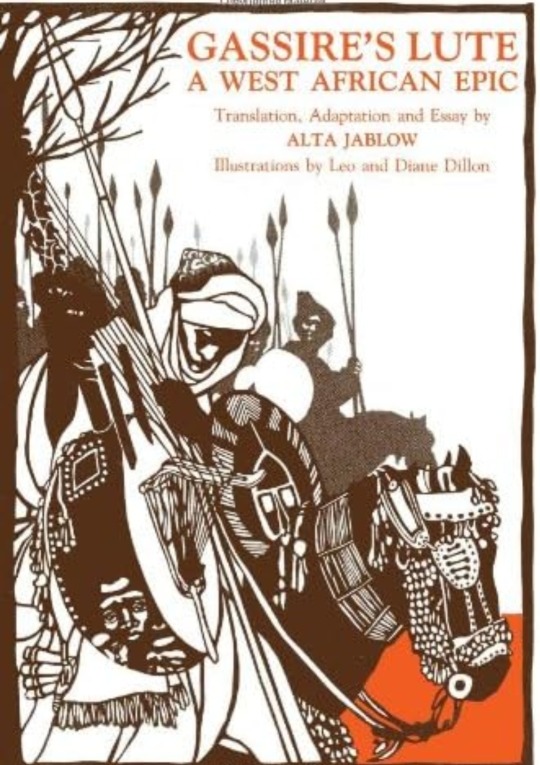
This orature legend of the birth of the Soninke bardic art chronicles the fall of Wagadou, the Soninke/Mande empire more popularly known as Ghana (not present day Ghana the country, which is named after this historical Mauritanian-Senegalese-Malian region empire).

Follow Gassire the warrior prince, who turns away from nobility to become his people's first diari (griot: bard).

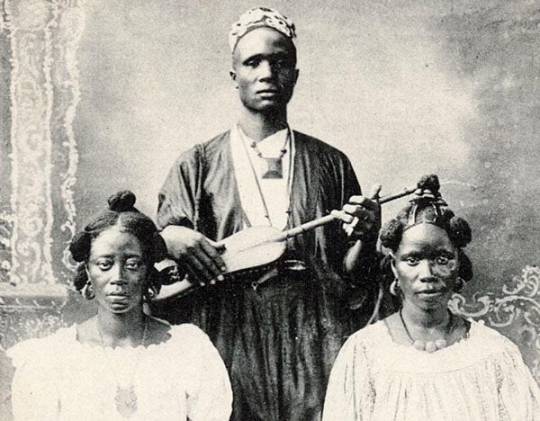
Here is a song named for the Soninke
https://open.spotify.com/track/55YdtD6BbmJ7NsDW4Z1Dpo?si=2Ogi-U2QQkuHoSZef_-PXw
Wagadou rose between the 1st-3rd century and fell in the 13th century, after being conquered by Sosso and submitting to the later Malian empire. Wagadou was preceded by Dhar Tichitt (1600 BC) and Djenne-Djenno, the ruins of which can be seen today. It was followed by Mali and Songhay, 2 of the most powerful kingdoms in the old Sahel.

Ghana means "warrior chief," and Wagadou (the Soninke name) could be named for the Wague (name for the nobility of the region) or named after the Soninke goddess. Legend says that when the 2 sons of the Kaya Maghan (king of gold, 800 Dinga Cisse, princes Khine and Dyabe fought over who should take the throne. Khine was victorious, continuing the Cisse Tounkara dynasty. However, Dyabe in humiliation, made a deal with the seven headed snake Bida, who promised victory over his brother in exchange for sacrificing a beautiful virgin every year. It was believed that the prosperity and gold that granted that prosperity was a result of these sacrifices, and so they continued until the brave fiance Maadi of the beauty Sia Yatabere was the first to rebel, slaying the snake and cutting its heads. Bida cursed Wagadu to drought and ruin, and sure enough, Wagadou fell, and the Soninke had to migrate southwards to find fertile land.
The now rare film Sia, Le Réve du Python, is based on this legend.
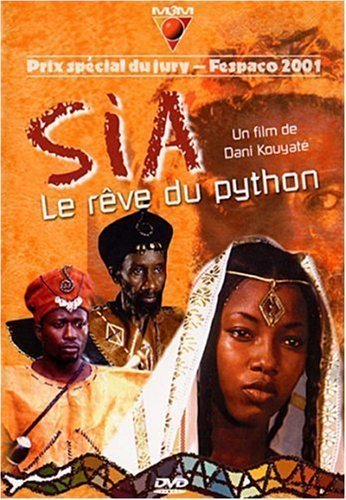
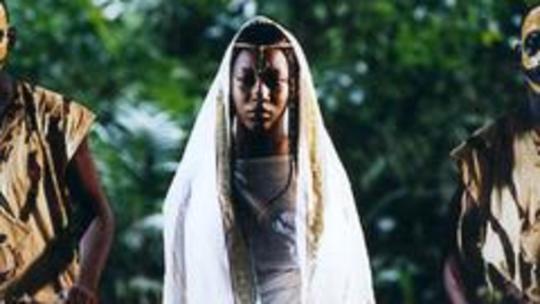
The capital of Ghana/Wagadou is believed to be Koumbi-Saleh. Here is an ambient instrumental piece paying homage to this ancient city:
https://open.spotify.com/track/4SRL7gOHRxrSb4TyvrBnvq?si=sNF5NePgQYqGOIsCbsdSCg
Vintage video of Soninke girls singing and flute player
https://youtu.be/bQm2aIVHakw?si=Rf3oYrcOsGnEAXTS
Soninke traditional drum dance
https://youtu.be/8FmiE_kdda0?si=7PQPVdYE0gNAJ4et

#sahel#sahelian history#soninke#wagadou#ouagadou#ghana empire#kaya maghan#sahelcore#bida#seven headed snake#wagadu#legend of wagadu#sia yatabere#sia dream of the python#dinga cisse#sahelian music#sahel aesthetic#gassire's lute#alta jablow#griots
8 notes
·
View notes
Text

Emperor Le Loi. Source: Bao Lam Dong website
In 1400, the Chinese Ming dynasty, taking advantage of internal turmoil in the Kingdom of Dai Viet, invaded Vietnam and briefly occupied it. Vietnamese general, Le Loi, led a nine year guerrilla resistance against the Chinese invaders and eventually drove them out. In 1428 he became Emperor of the restored Kingdom of Dai Viet, founding the Later Le dynasty. In 1431, the Ming formally recognised Vietnamese independence. Le Loi is one of the most famous heroes of Vietnamese history, and considered a national hero.
#vietnam#Vietnamese independence#le Loi#ming dynasty#sino vietnamese war#later le dynasty#kingdom of Dai Viet
0 notes
Text
Marie Antoinette: The Last Queen of France and Her Controversial Legacy
On 10th May, Louis XVI of France and his wife, the Austrian princess Marie Antoinette, began their reign. The young princess became the queen consort of France, a position that many desired. Marie Antoinette had a beautiful face and a graceful manner, and everyone was curious about what kind of queen she would be: a supporter of the arts, a subtle diplomat, a political counselor to her husband, a devout wife and queen? She ended up being all of these things – and more.
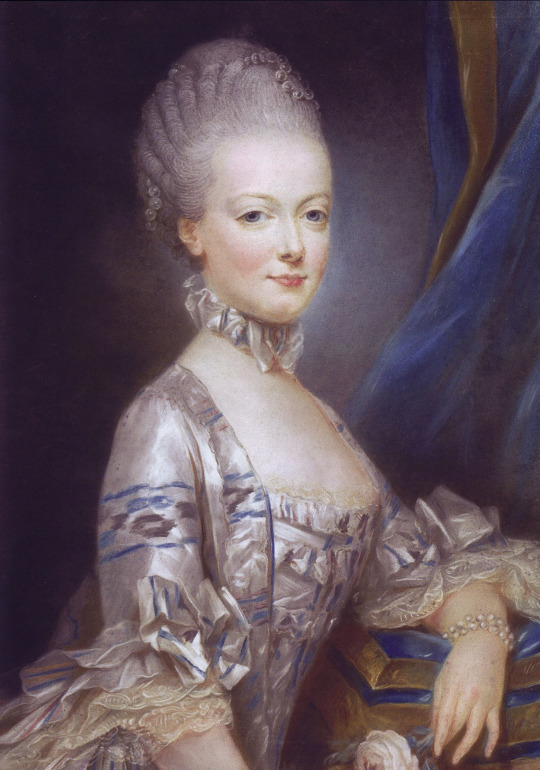
Archduchess Maria Antonia of Austria, the later Queen Marie Antoinette of France by Joseph Ducreux {PD}
She left a lasting impression on French history unlike any other French consort. Marie Antoinette was a talented musician – she played the harp and the harpsichord, and learned from Gluck in her childhood – as well as a singer and a fan of composers such as André Grétry. Marie Antoinette was also passionate about fashion and liked to invent new dresses and hairstyles, breaking with tradition and making the work of her ladies-in-waiting harder than usual.
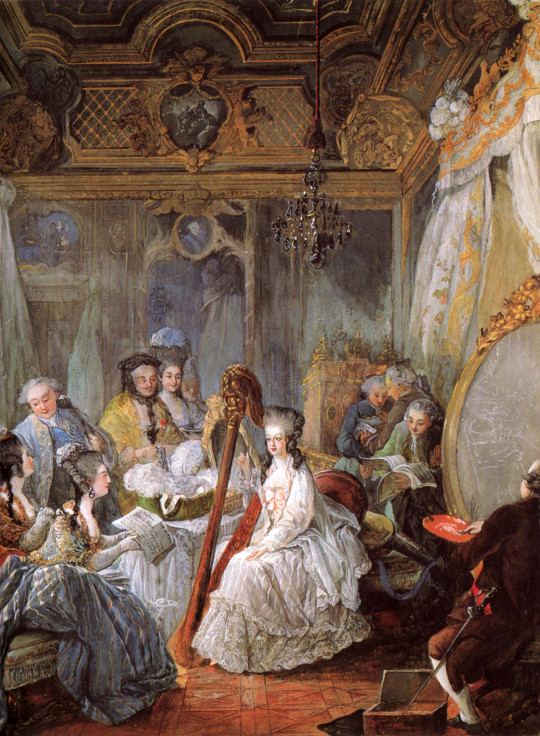
Marie Antoinette playing the harp at the French Court by Jean-Baptiste André Gautier-Dagoty {PD}
She enjoyed being daring – sculptures like this show her lively personality and extravagant style.
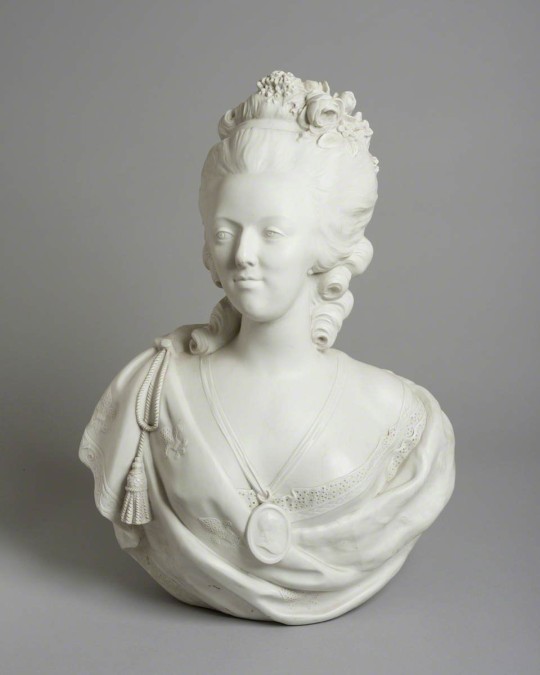
Marie Antoinette by Jean-Antoine Houdon, photo credit: Grundy Art Gallery, licensed under CC BY-NC-SA
Despite her great impact on the arts, Marie Antoinette was often regarded as the puppet of her mother, the Holy Roman Empress Maria Theresa – she was often attacked at the French court and called 'The Austrian' by her enemies. She soon became a scapegoat both at court and outside and, while she was initially loved by the French people, her lavishness during a hard economic time quickly turned this love into resentment. The more she tried to advise her husband in politics, the stronger the accusations against her became. She was vilified in pamphlets and libels, and her bad reputation affected her husband's as well.
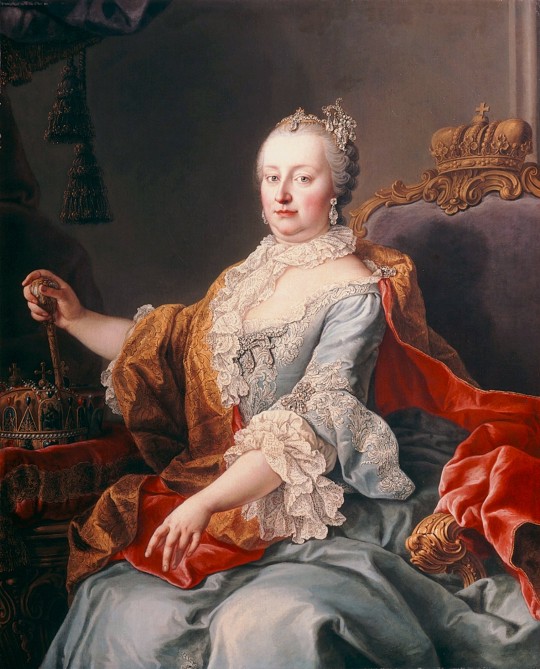
Empress Maria Theresia of Austria by Martin van Meytens {PD}
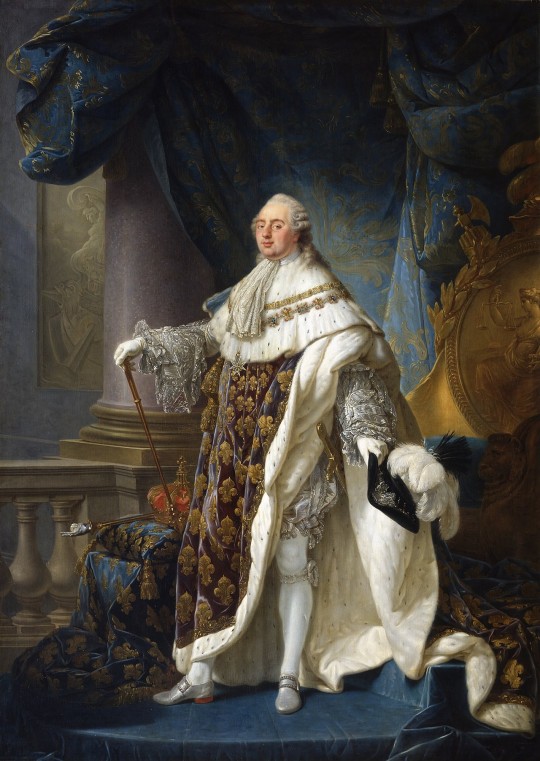
Louis XVI, King of France and Navarre, wearing his grand royal costume in 1779 by Antoine-François Callet {PD}
When the French Revolution started in 1789, Marie's mixed feelings about the situation caused a lot of damage to the French monarchy. She was advised by her family in Austria to escape, but she was conflicted between her willingness to compromise and her fears of the people's intentions. The royal family decided to flee, which led to the end of the monarchy in France.
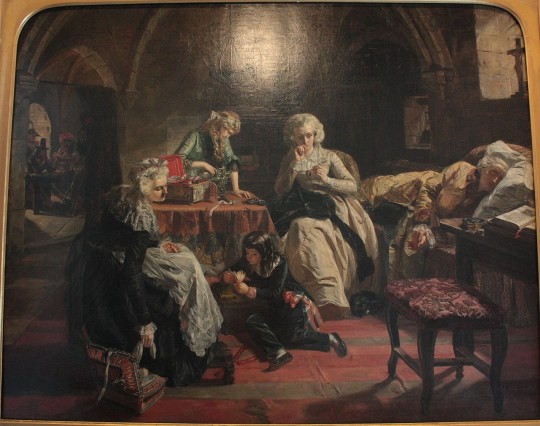
The Royal Family of France in the Prison of the Temple by Edward Ward
Louis XVI was tried for treason and eventually executed on 21st January 1793. His reign will always be remembered by his failure to preserve the monarchy and the Bourbon dynasty, and will always be linked to the French Revolution.
As for Marie Antoinette – who, as the consort of France, was supposed to have a wonderful destiny and future – her final moments were far from glamorous. She was imprisoned with her children and her ladies-in-waiting, and she was eventually tried for treason and executed on 16th October 1793, at the age of only 37.
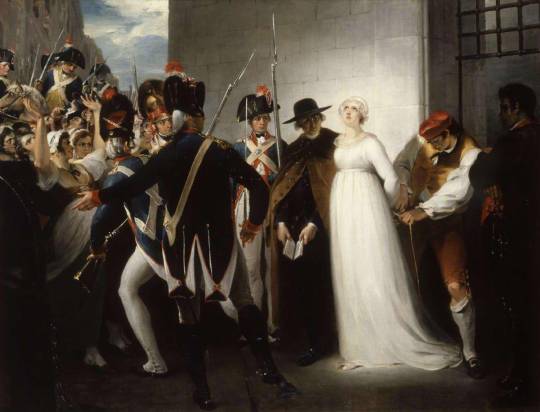
Marie Antoinette being taken to her Execution by William Hamilton {PD}
Her death caused outrage in the rest of Europe as most of her siblings were ruling other countries and realms. Her sister, Maria Carolina of Naples, swore to avenge her, developing a pure hatred against France for what they did. From an Austrian princess to a French queen consort, no one could have foreseen Marie Antoinette's terrible fate.
Marie Antoinette wrote to her sister-in-law, Madame Elisabeth, in her final moments. She had a close and sincere friendship with her over the years.
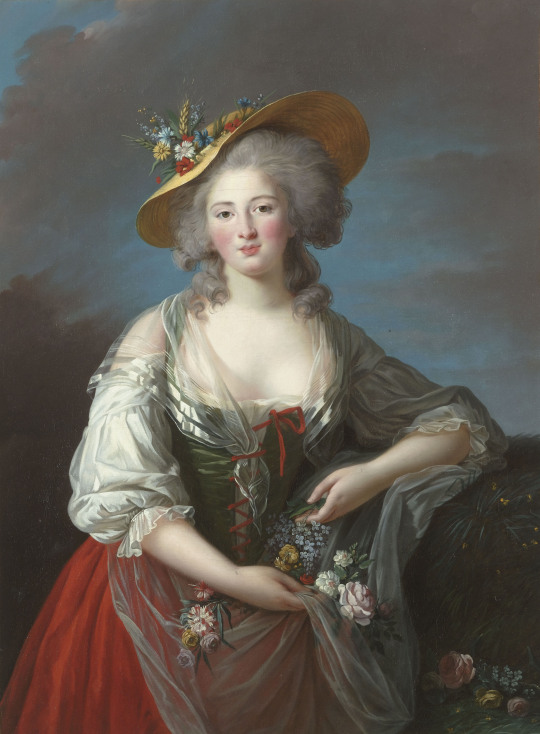
Elisabeth-Philippe-Marie-Hélène de France, dite Madame Elisabeth by Élisabeth Louise Vigée Le Brun {PD}
Her only thoughts were for her children, whom she wanted to protect desperately, even after her death. 'I am very saddened to leave my poor children; you know that they and you, my kind and loving sister, were my only reason to live.'
She advised, 'Let them both remember what I have always taught them, that virtuous principles and the faithful performance of every duty, are the first foundation of life; that their happiness will depend on their mutual love and trust.' She finished her letter with what she wanted her legacy to be: 'Let them never seek to avenge our death.' It was for her wise words and her maternal love that Marie Antoinette wanted her children to remember her.
Sadly, all her children died young except for Marie-Thérèse, who became the Duchess of Angoulême.
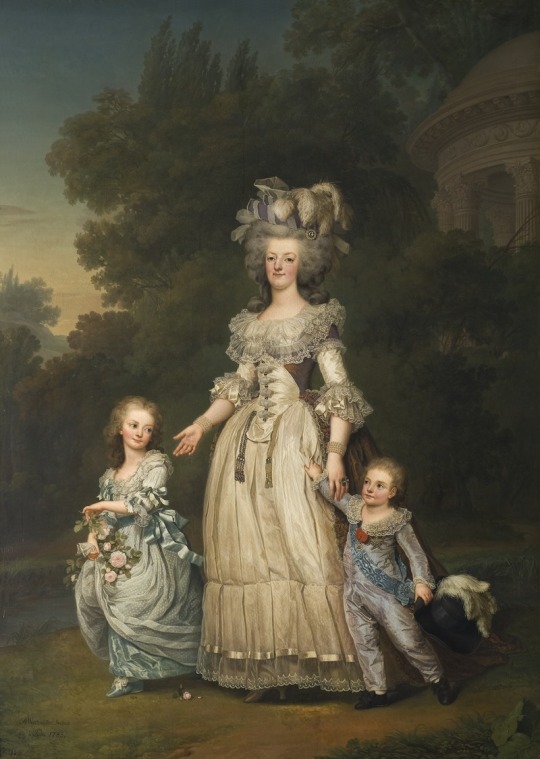
Queen Marie Antoinette of France and two of her Children (Marie-Thérèse Charlotte and Louis Joseph) Walking in The Park of Trianon by Adolf Ulrik Wertmüller (Nationalmuseum (Photo: Erik Cornelius)) {PD}

Portrait of Maria Theresia Charlotte of Bourbon by Heinrich Füger {PD}
Even today, especially in France, Marie Antoinette is a controversial figure. She is remembered for betraying France and for being the source of all its troubles, but her legacy is more complex, as her last letter shows. In the end, Marie Antoinette had her flaws, of course, but she also remained a loyal mother who was separated from her children and who tried to leave them a legacy of peace and love – if only through her words.
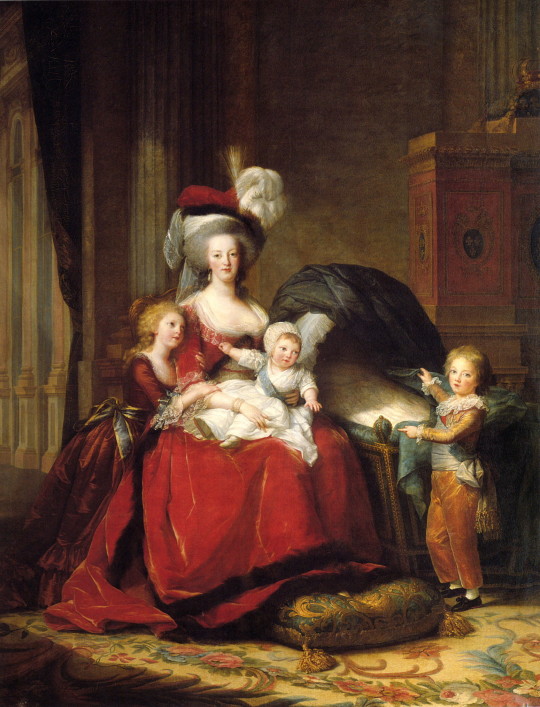
Marie-Antoinette de Lorraine-Habsbourg, Queen of France, and her children by Élisabeth Louise Vigée Le Brun {PD}
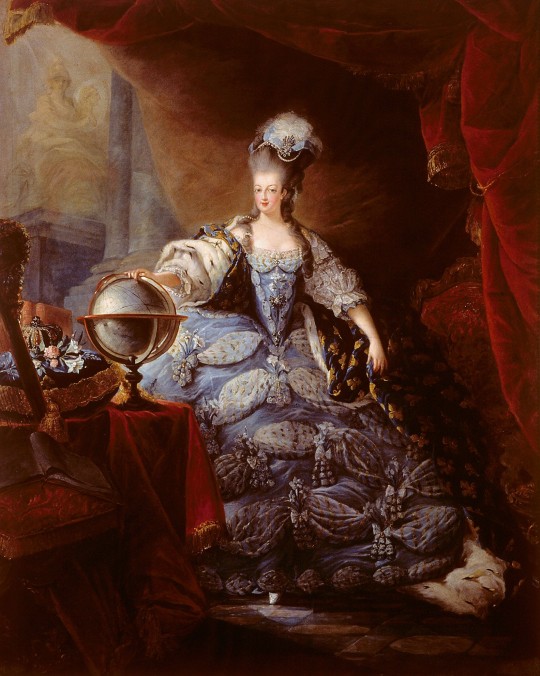
Portrait of Marie-Antoinette of Austria by Jean-Baptiste André Gautier-Dagoty {PD}
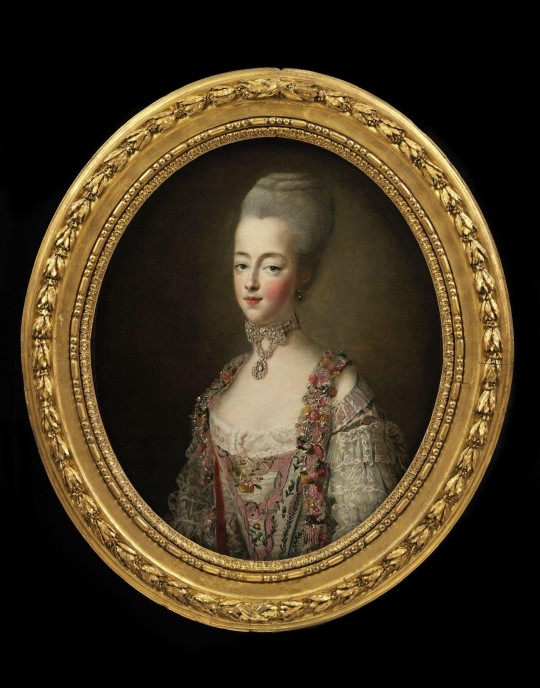

Marie Antoinette, Queen of France, in a court dress by François Hubert Drouais {PD}
#art#artwork#art history#artist#paint#drawing#marie antoinette#french revolution#kinglouis#classicart#queen of france#france#court#monarchy#exile#18th century#austria#monarch#history#geschichte#kunst
5 notes
·
View notes
Note
Who are your favourite female regents of Ancient China throughout the eras you know? Could you explain why and order them in accordance to your favourites? Sorry if this is being demanding.
My ranking of powerful empresses in the era I know (I'm expanding it to empresses who had political relevance)
Wu Zetian (Tang/Zhou), if we'll allow female emperors. Self-explanatory. She wasn't exactly a nice person, but god was her life epic.
Empress Dowager Feng (Northern Wei) - She created the equal field system which lasted into the Tang dynasty, encouraged the sinicisation reforms, and she basically shaped the cultural and economic policies of the Sui and Tang dynasty.
Empress Dugu Qieluo (Sui) - I think her political contributions were mostly positive. She did promote Yang Guang as crown prince, but I've already explained he did seem like a better option.
Empress Zhangsun (Tang) - I like her for her strength of character, giving honest advice to Li Shimin and helping with the Xuanwu Gate Incident.
Empress Liu E (Han Zhao) - Basically an early version of Empress Zhangsun.
Empress Lou Zhaojun (Northern Qi) - She seems to have tried her best to balance the conflict within her family, and she was able to advise Gao Huan.
Empress Dowager Luo (Cheng Han) - Fighting in battle kind of automatically puts you high on this list.
Empress Duan Yuanfei (Later Yan) - She had the intelligence to realise Murong Bao was not that good. However besides that she didn't do much.
Empress Liu (Shi Le's wife): She helped in military decisions and tried to plot against Shi Hu.
Princess Qi (Dai) - Ultimately we know nothing of her actual rule, only her scheming to get there, but the 女国 thing is cool.
Empress Liu Jingyan (Chen) - She ruled as regent for a short time for Chen Shubao. Given how incompetent Chen Shubao turned out to be, she was probably better than him.
Empress Chu Suanzi (Jin) - I've already explained her regencies. She did promote some decent officials, but her lack of action against Huan Wen puts her down.
Empress Zheng Yingtao (Later Zhao) - She didn't do much as empress dowager besides not wanting Ran Min to be killed.
Empress Liu (Later Zhao, Shi Hu's wife) - She did become regent but she was killed very quickly.
Empress Lu Huinan (Liu Song) - Like the ones mentioned above, she didn't do much politically. Also she might have been having an affair with her own son.
Empress Fu Xunying (Later Yan) - She didn't do much politically, but the extent to which Murong Xi favoured her is quite frankly completely ridiculous.
Empress Kezuhun (Former Yan) - She was corrupt and Former Yan declined during her reign. Empress Kezuhun's poor rule was a major factor in Fu Jian's conquest of Former Yan.
Empress Hu (Northern Wei) - I've already explained her in a separate post, but she wasn't competent.
Empress Jia Nanfeng (Jin) - She is described as having a terrible moral character, even if it's partly slander, and her political regime was unstable.
2 notes
·
View notes
Text
MIRACULOUS DYNASTIES: Introduction to an AU by T.A.M. Mulberry
READ THE 1ST CHAPTER HERE
Long ago, before the rise of machines, there were miracles…
For centuries, worthy heroes were given jewels that granted extraordinary magic from beyond this world. There are two miracle jewels, however, that stand on top of the hierarchy. The Ladybug of Creation and the Black Cat of Destruction. Juxtaposed for eternity — as one cannot live without the other.
Legend has it — that when both these jewels are used at the same time, one will have the power to alter reality itself.
“Are you willing to pay the price of absolute power?”
Copyright © 2024 by T.A.M. Mulberry

OVERVIEW
I started working on this AU by the time Season 3 was still airing. It is basically an alternate universe exploring a different timeline, origin and conflict for Marinette, Adrien and the rest of the crew. I've been wanting to share it for the past few years but never got around to doing it. Might as well do it later than never.
There won't be any major spoilers here since I have an entire story for this AU laid out for the world to see so if you ever find this post, make sure to stay tuned to any updates on le prologue chapter.
GENERAL CHANGES
Marinette and Adrien start out as 18-19 year old students that go to a Lycée Francoise Dupont of the Fine Arts instead .
The setting is in a post-modern futuristic Paris with advanced technology.
Most of the people in the story are from the Uptown area in Paris, because one of the themes in the story explores the superficiality of fame and money along with the dark side of being a celebrity.
The general tone and mood is darker but it's still cute and wholesome.
Miraculous and Miraculi are used interchangeably due to an in AU translation error by past historians.
The inheritance of Miraculi operate on a dynastic cycle that can be overthrown.
Less villains but are reoccurring
POWER SYSTEM
So this is my take on the Miraculous power system for this AU. I wanted it to be a lot grander and powerful so that the risks of wielding one will be even more apparent. This will only be showing a brief history, the kwami name change + other definition of terms and the types of miraculous.
DIFFERENT TERMS & ADDED TERMS
Chi / Qi: It is the general term for the power within someone.
Tianshi Energy: This is pure energy and it loosely translates to angel. It is a force that is created after a sacrifice.
Mogui Energy: Similar to an akuma, a Mogui translates to devil in Mandarin. It is a dark force that is created from the inner evil of human souls.
Qiji: The name change of the Kwamis. It means "miracle."
Miànshā: The veil that keeps the identities of Miraculous holders hidden.
ENERGY BALANCE / CHI
Because of an event that had happened in Ancient China that involved someone using both the Ladybug and Black Cat Miraculous to grant them the wish to drive out anyone that wanted to overthrow the Middle Kingdom, there was a sudden surge in Mogui energy that overthrew the Tianshi Energy. Overtime, this corrupted the state of the world as it continued to spread. That was, until Piao Chong and Hei Mao brought the balance back.
THE QIJI
For this AU, the kwamis are known by a Chinese term instead to be consistent with the lore of the Miracle Box because its roots in China will be explored.
The Qijis (pronounced: CHEE-jee) were first discovered by an Ancient Chinese Monk and they were the first ones to be converted into Miraculi, meaning that they were the oldest ones made. In English, it roughly translates to miracle which is why the Miraculi today are known as — well, Miraculous.
"Maybe we got lost in translation."
"You can't just insert a reference with no correlation to the topic at hand."
TYPES OF MIRACULOUS
YIN AND YANG MIRACULOUS
These are the first Qijis that manifested into existence. They are the most powerful Miraculi to be created and they were made to balance each other out. Only Creation can restore Destruction and only Destruction can completely destroy Creation. Even if they are individually more powerful than any of the other Miraculi, they need to simultaneously exist with each other to keep the balance.
Ladybug & Black Cat
LOTUS MIRACULOUS
These are the Miraculous that manifested from both the concepts of Creation and Destruction. They are not as powerful but they do have more specific applications. They are based on the different aspects of a human psyche and represent the different Chinese elements. Because they rely on both Yin and Yang aspects that have stemmed from the Ladybug and Black Cat, they also have passive abilities when they are detransformed.
Turtle, Moth, Peacock, Fox & Bee
ZODIAC MIRACULOUS
Now these are the Miraculi that stemmed from the Lotus Miraculi. While the ones mentioned are based on the Human Psyche, the Zodiac is based on the natural world and the abiotic elements of it. They all have different forms that change depending on the season, natural phenomena or internal balance. However, their fifth forms all give them a limit of 5 Minutes to use before transforming back and they cannot switch between forms while in transformation.
Rat, Ox, Tiger, Rabbit, Dragon, Snake, Horse, Goat, Monkey, Rooster, Dog & Pig
TIMELINE
PREHISTORY - The Eons of Wild
“Eons have passed, floating in space Without a name and without a face The avatar of creation had nothing to create Until destruction birthed another with no name.”
— a passage from the ancient days
ANCIENT HISTORY – The Age of Miracles
"It was only during then that the beings that have existed longer than all of human history were given names. They started to embody the traits that early humans possessed and observed them from birth to death. A fragile existence."
— an excerpt from historical research
MIDDLE AGES – The War of Regimes
"Elite families were originally chosen by the monk that created the jewels. However, just as dynasties can be overthrown, so can the families of ancient history."
— an excerpt from historical research
MODERN HISTORY - The Rise of Machines
"Revolution. Industry. Progress. Suppression. The future. The rise of machines was the fall of the old world. The fall of miracles."
— an excerpt from a monk.
MAIN TIMELINE — The Convergence
As the leaves began to fall, it was a sign that school was back in session; and for the eager high school students of Lycée Françoise Dupont of the Fine Arts, it was another opportunity to make it big in the industry. The hustle and bustle of aspiring musicians, actors and authors showed just how everyone was determined to make it there on time.
At least … most students were.
— an excerpt from Chapter 1

Stay tuned for more updates on this AU! I hope that you'll find something enjoyable about it once it comes out.
T.A.M. Mulberry
#miraculous au#miraculous ladybug#mlb au#marinette dupain cheng#adrien agreste#paris france#miraculous kwamis#miraculous fandom#writers on tumblr#zodiac
4 notes
·
View notes
Text
Ngọn cỏ gió đùa của Hồ Biểu Chánh
Text by Thụy Khuê
In this article, she (Thụy Khuê) wrote an introduction to the 1926 novel by Hồ Biểu Chánh.
[Translated from Google translate:]
Jean Valjean, Vietnamized under the identity of Le Van Do, a poor farmer, during a time of famine, could not find work. Because he could not bear to see his 7 grandchildren about to starve to death, Le Van Do secretly carried a pot of porridge to feed the pigs, at a rich landlord's house, was caught, rushed in and beaten. Le Van Do resisted. In the end, he was still caught. He was beaten 100 times, sentenced to 5 years in prison for robbery and assault. He escaped from prison many times, each time increasing the sentence, for a total of 20 years before being released.
From a simple and honest farmer, he never felt resentment when he went to prison.
20 years later, after being released from prison, Le Van Do became a taciturn and aggressive bandit.
[...]
Monk Chanh Tam did not get angry, he just treated Do like an honored guest, gave him new clothes, food, and a place to sleep. The monk used to be an official with the rank of Án Sát (the king gave him a set of bowls), but because he was tired of the corruption of the officialdom, he returned to become a monk.
[Án Sát, according to Vietnamese Wikipedia is a Surveillance Commissioner, is the chief of the Surveillance Office, with the rank of the fourth-rank civil servant. As a department under the Ministry of Justice and holding important responsibilities at the provincial and municipal levels, the Surveillance Office is responsible for security, litigation, justice, discipline, and postal services.
During the Nguyen Dynasty (in which this novel is set in), the An Sat Su was one of the four provincial-level officials (Bo Chinh , An Sat, Doc Hoc , Lanh Binh) forming the closest staff of the Governor-General to direct activities in the province and at the prefecture, district, canton, and commune levels.]
Le Van Do waited until everyone was asleep, stole the monk's jade bowl set and snuck away. He was caught on the way, and the village chief found the stolen items from the temple, brought them back to the temple for the monk to identify before sending them to the district to be punished by the authorities. The monk [denied the claim of a crime, and] also gave 5 more silvers (nén bạc) for Le Van Do to have enough money to go back to his hometown to make a living.
[Nén bạc - I don't know if this means ingots or coins. But you are more than welcome to search the term on Google Images to try and get a picture of what he gave him. Or just ask a Vietnamese person I'm guessing.]
Le Van Do continued his journey home, on the way he still did wrong: he snatched the rice pot from an old beggar couple in the middle of the road. But this time, when Do had just found a quiet place to take out the rice pot to eat, he heard a crow cawing.
As soon as the crow stopped, Do was about to pick up some rice to eat, when he heard the bell ringing which startled Do. But "whenever he heard the bell ring, he shivered, then in his ears he heard the wailing of the old couple" whose rice had been stolen. Do had no choice but to turn back and secretly return the rice pot to the beggar couple that he had snatched earlier, then he could feel his mind calm down.
Le Van Do's situation was no different from Sun Wukong, every time he did wrong, he had a headache because the Buddha's golden ring tightened.
When he returned to his hometown, his mother had died, his grandchildren had also starved to death, and his sister-in-law had wandered off to an unknown location.
Thanks to the monk's kindness, Le Van Do used 5 silver (ingots?) to establish himself, changed his name to Chanh Tam, cleared the forest to make fields, and became a wealthy landowner.
Anh Nguyet is Fantine's counterpart, and she dies in poverty as she wanted to keep her chastity.
Gavroche is omitted from the book.
2 notes
·
View notes
Text
I've been meaning to write this since @luckthebard 's post about the fandom's treatment of the whole Ludinus situation but I'm only getting to it now, and didn't want to hijack the og post. The basic point of this is that it made me realize that this is basically the same discourse as "Luke was right" in Percy Jackson.
You have the gods, of Exandria or Olympus, who are somewhat questionable in world.
You have a guy, Ludinus or Luke, that feels like he's been wronged by the gods, some could say that this feeling is accurate, some would disagree (I believe that's a interesting in-game convo, don't know how relevent it is outside of it).
This guy then wants to get rid of the gods, to set up a new world order, and to do so, he makes an alliance with an older being, that existed prior to the gods (Predathos or Chronos).
This older being wants to kill the gods for his own interests and is using the guy as a means to an end, while the guy believes he's bringing forth lasting change.
Both fandoms ask at some point, "is the guy right ?". Because the guys criticizes an imperfect system, but with violent and unfit means.
That's about all I have to say about pjo, I just wanted to point out the parallel.
To the second part of this post.
I think the only thing with which I disagree from the og post is the seemingly firm belief that the criticism of the gods by the fandom is unfounded.
I'll add that the comparison to Evangelical American Christianity isn't quite relevant to me, or at least misses the point of some of the criticism. This specific way to practice Christianity and Christianity in general is not inherently bad or evil or wrong, nothing is. Did they do horrible things in the past ? damn right. Should they make amends ? damn right. Are they still today being used as a symbol and a way to justify horrible things ? right again.
But as true as all of this is, I think it is just skirting what is actually criticized about religion in general here or in extreme atheist circles. I'll quote Le Guin here "religion, yes, clergy, no.". The problem is not the religion in and of itself, it never is. The problem is the institution it creates and how this institution is then used as a tool of oppression. And absolutely every religion can fall victim to this, none is exempt.
That is true of real life religion, and our fake fantasy religions. The Dwendalian Empire forces strong restriction on worship, and shockingly, they're (it's in the name) a whole ass empire, whose control of the religion practiced by its people allows it to control its general array of thought. One could argue that the Kryn Dynasty also uses the worship of the Luxon as a tool of control of their elites and population, but let's keep that for another day.
I also think the hole in the og post's argumentation is saying that we have had good interactions with the gods before, and following a few paragraphs later with "our personal relationships with individual gods and feelings about them are irrelevant actually".
And yeah, we've seen great interactions with the gods, but the gods are not what are criticized in anti-religion movements, again, the problem is in the institutionalization of it.
I'll end this by saying that I do understand that the problem pointed out in the og post was the support given to Ludinus. Regarding this, I definitely agree with Luck. Even if I think there is criticism to be made about organized religion in whatever form, that's really not what Ludinus is doing. His problem seems to be the gods themselves and not the institution of them, which means I believe he's missing the point as well.
There is of course, the question of violence as a means to an end, and if you're interested by this as a philosophical debate, I'll advise reading a bit about utilitarianism in general and some famous books and plays (The Just Assassins, by Albert Camus ; Ivan Karamazov's speech to his brother Aliocha in Dosyoevsky's The Brothers Karamazov ; really basic trolley problem stuff ; and Camus wrote a lot about the use of violent means in war in various texts, including Resistance, Rebellion, and Death). But we're in a fantasy world, and a D&D game, and they kill a bunch of people and creatures all the time, so the moral aspect of violence or non-violence is also not the same as in real life.
I believe violence is at times necessary for change, and it is always necessary to overthrow an oppression which uses violence first (for more about this, I would advise reading Frantz Fanon and Paulo Freire).
However, Ludinus is not thriving to overthrow this oppression in its institutional form, but wishes only to suppress the people currently in power, without changing the minds of the people or the way they think power, which in turn will keep the oppression alive (which is why revolutionary movements have to come from the people and not the elite).
TL;DR: LUDINUS IN CR IS BASICALLY LUKE IN PJO, AND EVEN IF LUDINUS IS 100% WRONG, THERE ALWAYS IS A CRITICISM TO BE MADE AGAINST ORGANIZED RELIGION SEEING AS IT IS OFTEN USED AS A TOOL OF OPPRESSION.
#critical role#cr discourse#pjo#percy jackson and the olympians#ludinus da'leth#ludinus#luke castellan#luke#percy jackson#predathos#chronos#cr#saying again that this is in no way against luck's opinion or against anything#just an observation#and an observation open to discussion and criticism if it is constructive#it's interesting to think about but dont get too worked up about it#i didnt mean for it to be this long...
16 notes
·
View notes